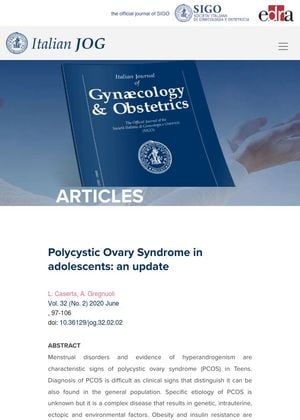TLDR The document concludes that PCOS in teenagers is hard to diagnose, influenced by various factors, and should be managed with lifestyle changes and medication.
The document from 3 years ago, "Polycystic Ovary Syndrome in adolescents: an update", discussed that Polycystic Ovary Syndrome (PCOS) in teenagers is characterized by menstrual disorders and signs of hyperandrogenism. However, diagnosing PCOS is challenging as its clinical signs can also be found in the general population. The specific cause of PCOS remains unknown, but it is a complex disease influenced by genetic, intrauterine, ectopic, and environmental factors. Obesity and insulin resistance are commonly associated with PCOS, putting patients at risk of metabolic and cardiovascular diseases. The paper recommended lifestyle changes and drug therapy for all patients to control and counteract the development of hyperandrogenism and menstrual disorders.
 October 2010 in “Cambridge University Press eBooks”
October 2010 in “Cambridge University Press eBooks” Lifestyle changes like diet and exercise are key for treating overweight women with polycystic ovary syndrome.
 62 citations
,
April 2013 in “Steroids”
62 citations
,
April 2013 in “Steroids” PCOS symptoms change with age; younger women have higher androgen levels and less metabolic issues, while older women face more metabolic challenges despite milder PCOS symptoms.
 1514 citations
,
December 2011 in “Fertility and sterility”
1514 citations
,
December 2011 in “Fertility and sterility” Experts agree that PCOS affects women's health in complex ways, but more research is needed to understand and treat it effectively.
 87 citations
,
July 2018 in “Nursing Clinics of North America”
87 citations
,
July 2018 in “Nursing Clinics of North America” PCOS is a common hormonal disorder in women, marked by symptoms like hair growth and menstrual issues, and requires personalized treatment.
 19 citations
,
January 2013 in “Pediatrics in review”
19 citations
,
January 2013 in “Pediatrics in review” The document says menstruation is important for women's health, discusses menstrual disorders, and suggests personalized treatment options.
 343 citations
,
December 2008 in “Endocrine Reviews”
343 citations
,
December 2008 in “Endocrine Reviews” Metformin helps with menstrual cycles and insulin levels in PCOS but is less effective for hair growth, diabetes prevention, and weight loss, and may improve fertility and reduce diabetes risk.






